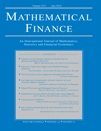
MATHEMATICAL FINANCE
Scope & Guideline
Exploring the Intersection of Mathematics and Finance
Introduction
Aims and Scopes
- Quantitative Risk Management:
The journal emphasizes rigorous mathematical and statistical methods for assessing and managing financial risk, including market, credit, and operational risks. - Stochastic Modeling:
Research includes the development of stochastic models to describe the dynamics of financial markets, including asset prices, interest rates, and volatility. - Portfolio Optimization:
Papers often explore advanced techniques for optimizing investment portfolios under various constraints and market conditions. - Machine Learning and AI Applications:
The journal showcases innovative applications of machine learning and artificial intelligence in finance, such as algorithmic trading, risk assessment, and predictive analytics. - Game Theory and Economic Equilibria:
Research frequently incorporates game-theoretic approaches to understand competitive behaviors in financial markets and establish equilibrium concepts. - Derivatives Pricing and Hedging:
A core focus is on the pricing and hedging of financial derivatives using sophisticated mathematical techniques and models.
Trending and Emerging
- Deep Learning and AI in Finance:
There is a growing trend towards utilizing deep learning techniques for various applications in finance, including asset pricing, risk management, and algorithmic trading, reflecting the industry's interest in harnessing big data. - Systemic Risk and Financial Stability:
Research increasingly addresses systemic risk and the implications of interconnected financial systems, particularly in the context of multiple central counterparties and the stability of financial markets. - Dynamic and Time-Inconsistent Models:
There is an emerging focus on dynamic models that account for time-inconsistency in decision-making, which is crucial for realistic modeling of investor behavior and market dynamics. - Reinforcement Learning Applications:
Reinforcement learning is becoming a prominent area of study, with applications in optimal trading strategies, market simulations, and risk management, showcasing its potential to revolutionize traditional finance methodologies. - Multi-Agent Systems and Market Simulations:
Research on multi-agent systems is gaining traction, particularly in simulating over-the-counter markets and understanding interactions among heterogeneous agents.
Declining or Waning
- Traditional Asset Pricing Models:
There is a noticeable decrease in the focus on classical asset pricing models, suggesting a shift towards more complex, data-driven approaches that incorporate machine learning and other modern techniques. - Static Risk Measures:
Static risk measures, such as Value-at-Risk, which previously received significant attention, are being overshadowed by dynamic and robust risk measures that account for changing market conditions. - Simple Hedging Strategies:
Research on basic hedging strategies appears to be waning, as the focus shifts towards more sophisticated and adaptive strategies that incorporate real-time data and machine learning.
Similar Journals

Journal of Investment Management
Advancing Knowledge in the Dynamic World of Investment Management.The Journal of Investment Management, with ISSN 1545-9144 and E-ISSN 1545-9152, is a prominent platform dedicated to the dissemination of cutting-edge research in the field of investment management. Published by JOURNAL INVESTMENT MANAGEMENT, this journal aims to bridge the gap between theoretical foundations and practical applications, catering to the needs of researchers, professionals, and students alike. With a focus on contemporary issues influencing investment strategies, asset allocation, risk management, and financial innovation, this journal provides valuable insights and methodologies to enhance investment decision-making processes. While currently not operating under an open-access model, the journal is accessible through various academic databases, ensuring that its critical findings reach a wide audience across the globe. Emphasizing the significance of empirical research and analytical rigor, the Journal of Investment Management plays a crucial role in shaping the future of investment practices and academic discourse in this dynamic field.
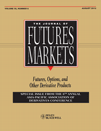
JOURNAL OF FUTURES MARKETS
Empowering Scholars with Cutting-Edge ResearchThe JOURNAL OF FUTURES MARKETS, published by WILEY, stands at the forefront of research in the fields of accounting, economics, finance, and business management. With an ISSN of 0270-7314 and E-ISSN 1096-9934, the journal has been a key academic resource since its inception in 1981, with content converging up to 2024. It is recognized for its rigorous peer-review process and maintains a strong presence in the academic community, holding a Q2 ranking in multiple categories such as accounting and finance, according to the latest 2023 evaluations. With a reputable Scopus ranking, where it ranks in the 65th percentile for economics and econometrics, this journal is essential reading for researchers, professionals, and students alike who seek to explore the complexities of future markets. While not an open-access publication, it offers various subscription options that make cutting-edge research accessible to a broad audience, fostering a deeper understanding of market dynamics and trends.
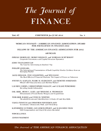
JOURNAL OF FINANCE
Elevating understanding in finance and economics.JOURNAL OF FINANCE, published by Wiley, stands as a premier academic journal in the fields of finance, economics, and accounting. With a history dating back to 1946, the journal has consistently delivered impactful research that shapes financial theory and practice, boasting an impressive impact factor reflective of its high citation rate. Its Quartile 1 ranking in Accounting, Economics and Econometrics, and Finance illustrates its leading position within these disciplines. Although not an open access publication, the journal continues to be indispensable for researchers, professionals, and students seeking to advance their understanding and knowledge through rigorous empirical analysis and comprehensive reviews. With an esteemed global readership, the JOURNAL OF FINANCE remains committed to fostering the dissemination of innovative financial research well into 2024 and beyond.

JOURNAL OF PORTFOLIO MANAGEMENT
Unlocking Insights for Optimal Portfolio PerformanceJOURNAL OF PORTFOLIO MANAGEMENT is a premier academic journal dedicated to advancing the field of finance through rigorous research focused on investments, asset management, and portfolio strategies. Published by PAGEANT MEDIA LTD in the United States, this journal has established itself as a vital resource for finance professionals and scholars alike, as evidenced by its consistent ranking in the Q2 category across disciplines such as Accounting, Business Management, Economics, and Finance according to the latest categorization. With an emphasis on empirical studies and theoretical advancements since its inception in 1995, the journal remains a key player in the academic landscape, offering insights valuable for both researchers and practitioners. Although not an open-access journal, it provides access to high-quality, peer-reviewed articles that contribute significantly to the discourse on portfolio management. The ISSN for traditional publications is 0095-4918, while the E-ISSN is 2168-8656, ensuring wide-reaching dissemination of complex financial concepts. Immerse yourself in the latest findings to enhance your understanding and application of portfolio management strategies.
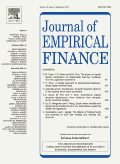
Journal of Empirical Finance
Unveiling the data behind financial phenomena.Journal of Empirical Finance, published by Elsevier, stands as a key resource in the areas of finance and economics, with a definitive focus on empirical studies. As a prominent journal since its inception in 1993, it has made significant strides in contributing to the academic community, evidenced by its soaring categorization in Q1 for Finance and Q2 for Economics and Econometrics as of 2023. With an ISSN of 0927-5398 and an E-ISSN of 1879-1727, the journal emphasizes robust, data-driven analysis to inform both theoretical and practical aspects of financial research. While access options do not include open access, the journal ensures that its content remains accessible to a diverse audience of researchers, professionals, and students. It fosters a platform for innovative research and discourse, significantly impacting the fields of finance, economics, and econometrics. The Scopus rankings further bolster its reputation, placing it in the 61st percentile in both categories, reflecting a commitment to high-quality research output. As the journal continues to evolve, it invites contributions that push the boundaries of empirical finance, enabling a deeper understanding of financial mechanisms that drive global economies.

Pacific-Basin Finance Journal
Empowering Researchers with Cutting-Edge Finance InsightsPacific-Basin Finance Journal is a prestigious academic journal that focuses on critical developments and innovative research within the fields of finance and economics, specifically tailored to the Pacific region's unique economic landscape. Published by Elsevier, the journal boasts an impressive impact factor and is categorized in the Q1 quartile for both Economics and Econometrics and Finance as of 2023. This indicates its high relevance and position among the top journals in its field, with Scopus rankings reflecting a strong standing in the competitive landscape of finance research, holding the 45th position out of 317 in Finance and the 108th in Econometrics. Established in 1993, the journal is committed to disseminating rigorous theoretical and empirical research findings that enhance the understanding of financial systems in the Pacific Basin. Although the journal is not open access, it provides invaluable insights and comprehensive studies aimed at professionals, researchers, and students alike, fostering a deeper comprehension of the region's economic dynamics and global interconnectedness.

Journal of Investment Strategies
Transforming Investment Practices through Rigorous ResearchThe Journal of Investment Strategies, published by INCISIVE MEDIA, is a distinguished periodical focusing on pivotal issues within the realms of economics, finance, and management. With the ISSN 2047-1238 and E-ISSN 2047-1246, this journal has been making strides since its inception, presenting innovative research from 2018 to 2024. Designated in the Q2 category for both Economics, Econometrics and Finance and Strategy and Management as of 2023, it exemplifies its role as a crucial platform for scholars and practitioners who aim to disseminate knowledge and innovative strategies in investment. Although currently not open access, it provides robust insights into finance advocacy, economic dynamics, and strategic management practices. Researchers, professionals, and students alike can benefit from the journal's high-quality contributions that stimulate discussions and advance the understanding of complex investment landscapes, making it an essential resource in the pursuit of excellence in these competitive fields.

Annual Review of Financial Economics
Exploring the Dynamics of Economics and FinanceAnnual Review of Financial Economics, published by Annual Reviews, stands as a pivotal journal in the fields of Economics and Finance, recognized for its rigorous analysis and comprehensive reviews since its inception in 2010. With an impressive impact factor reflected in its Q1 ranking in both Economics and Econometrics and Finance for 2023, this journal serves as an essential resource for researchers, professionals, and students keen on understanding the dynamic interplay of financial theories and practices. The ISSN 1941-1367 and E-ISSN 1941-1375 signal its commitment to accessibility and dissemination of cutting-edge research within the community. Addressing crucial topics from market behavior to economic modeling, each annual volume synthesizes the latest findings and theoretical advancements, thus contributing significantly to the global discourse within financial economics. With its high Scopus rankings, including a finance rank of #75 out of 317, the journal continues to foster a deep understanding of financial systems and their implications, serving as an invaluable tool for anyone engaged in the broader economic landscape.
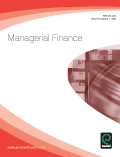
MANAGERIAL FINANCE
Unlocking Strategies for Contemporary Financial Challenges.MANAGERIAL FINANCE is a prestigious academic journal published by Emerald Group Publishing Ltd, focused on the areas of finance, management, and strategy. With an ISSN of 0307-4358 and an E-ISSN of 1758-7743, this journal has carved a niche for itself within the business and financial sectors, achieving a commendable Q2 category ranking across multiple domains, including Business, Management and Accounting, Finance, and Strategy and Management, as of 2023. The journal aims to provide a platform for insightful research and critical analysis while fostering an understanding of contemporary financial practices and theories. With its wide-ranging scope, it serves as a vital resource for researchers, professionals, and students alike, looking to stay abreast of the latest trends and challenges in managerial finance. The editorial board is committed to maintaining academic rigor, ensuring that articles published are of the highest quality and relevance to the field. By bridging the gap between theory and practice, MANAGERIAL FINANCE is an essential reference for anyone involved in financial decision-making and strategic management.

Annals of Finance
Elevating Discourse in Economics and FinanceThe Annals of Finance, published by Springer Heidelberg in Germany, stands as a pivotal journal within the realms of Economics, Econometrics, and Finance. With a dedicated convergence of research from 2005 to 2024, this esteemed publication features thought-provoking articles that address both theoretical and practical aspects of finance, earning it a commendable Q2 category ranking in the 2023 metrics for both Economics, Econometrics and Finance as well as Finance. The journal serves an essential role in disseminating knowledge and fostering advancements in the field, appealing to researchers, professionals, and students alike. Its rigorous peer-review process ensures the integrity and quality of published works, making it a reliable source for cutting-edge findings and discussions within the finance community. For those looking to navigate the complexities of modern finance through rigorous research, the Annals of Finance is an invaluable resource.